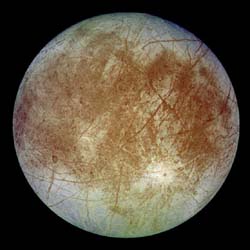Europa
Phoenicia princess abducted and taken to Crete by Zeus transformed into bull.
The smallest of the four Galilean moons (slightly smaller than our own Moon) and the second nearest Galilean to Jupiter after Io. Europa's surface is remarkably smooth and flat, with no differences in relief of more than a few hundred meters. The surface composition of water ice results in an albedo five times higher than that of the Moon.
Two types of terrain are in evidence. The first is mottled reddish-brown or gray and covered mainly by small hills. Linear ridges in these regions are thought to be the frozen remnants of cryo-volcanic activity where liquid or partially frozen water has erupted onto the Europan surface and instantly frozen. The second type of terrain consists of smooth plains, criss-crossed by large numbers of cracks, both curved and straight, some extending for thousands of kilometers.
The fracture patterns closely resemble those seen in the broken ice pack in the Earth's Arctic and Antarctic Oceans. From these surface clues, and the fact that Europa is heated internally both by tidal forces and radioactive decay, scientists have hypothesized that a sub-surface ocean of liquid might exist on the moon (see Europa, ocean on) and that, if this is the case, life of some sort may have evolved in it (see Europa, life on). Few craters are in evidence, especially larger ones, suggesting that the surface has been resurfaced within the past few million years. Europa, like Io, is suspected of having an iron-sulfur core.
Observations with the Hubble Space Telescope in 1994 revealed the presence of a tenuous atmosphere of oxygen molecules, with a pressure barely one hundred billionth that of the Earth. In the words of one of the researchers who made the discovery: "If all the oxygen on Europa were compressed to the surface pressure of Earth's atmosphere, it would fill only about a dozen Houston Astrodomes." The oxygen is non-biological in origin. Europa's icy surface is exposed to sunlight and is impacted by dust and charged particles trapped within Jupiter's intense magnetic field. Together these processes cause the frozen water ice to produce vapor as well as gaseous fragments of water molecules. After the gas molecules are produced, they undergo a series of chemical reactions that ultimately form molecular hydrogen and oxygen. The relatively lightweight hydrogen gas escapes into space, while the heavier oxygen molecules accumulate to form an atmosphere which may extend 200 km (125 miles) above the surface. Since the oxygen gas slowly leaks into space, it is clear that it must be continuously replenished.
In September 1999, the discovery was announced, based on infrared data from Galileo, of frozen sulfuric acid on Europa. This may originate from inside the moon or from volcanoes on neighboring Io. Either way, the implications for the possibility of Europan life are ambiguous. While sulfuric acid is an unpleasant chemical for humans, many bacteria on Earth prosper in sulfur- and acid-rich environments.
| Europa facts | |
| Discovery: | 01-7-1610 by Galileo |
| Diameter (km): | 3,138 |
| Mass (kg): | 4.8 x 10²² |
| Surface Gravity (Earth = 1): | 0.135 |
| Mean Distance from Jupiter (km): | 670,900 |
| Orbital period (days): | 3.5512 |
| Rotational period (days): | 3.5512 |
| Density (gm/cm³) | 3.01 |
| Orbit Eccentricity: | 0.009 |
| Orbit Inclination (degrees): | 0.47 |
| Orbit Speed (km/h): | 49,464 |
| Escape velocity (km/sec): | 2.02 |
| Visual Albedo: | 0.64 |
| Surface Composition: | Water Ice |
| Temperature (k) | 111 |
Text from David Darling’s encyclopedia.

